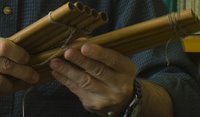Technorati Tags: Occult or Smithsonian Tropical Research Institute and International Congress of Americanists or supernatural and Yanesha or linguists and anthropologists or ethnographic and Archaeology or biology, and Sun God,
 | Pan-pipes thought to be imbued with the soul of the Sun-God Credit: Marcos Guerra, STRI, Smithsonian Tropical Research Institute |
Is it possible that "inanimate objects" have a life of their own? Fernando Santos-Granero, STRI Staff Scientist, is organizer of "The Occult Life of Things," a symposium at the International Congress of Americanists in Seville, Spain on 17 July, 2006. Natives of the Amazon region consider animals, plants and objects as subjectivities that have lives of their own and are essentially social beings.
This "animistTM" vision of the world goes hand in hand with a "perspectivistTM" vision in which all beings and things view 'self' as human and "other" as non-human. The focus of the symposium is an analysis of these occult lives; occult not only in the sense that the lives of things are supernatural, but also because the human essence of things is not normally visible.
The Yanesha of eastern Peru believe that pan pipes are animated by the Sun God, the Creator, explains Santos-Granero. Before playing the pipes, Yanesha men offer fermented manioc drinks, coca leaves or tobacco juice to "raise its spirit." When they play the flute, the life-giving force of the Sun God is broadcast to all nearby beings and things.
The symposium will gather linguists and anthropologists from Europe, South America, and the United States who are specialists on Native Amazonian societies. Participants will address three major aspects of the life of things.
The subjective aspect of objects. How do Amerindians mark the difference between animate and inanimate things? Do all things have a subjective dimension? How does the subjectivity of things manifest itself?
The social aspect of things. In what contexts does the relationship between people and things become inter-subjective? Do things have social or historical agency? Are the relationships between people and things conceived of as power relations?
The historical aspect of things. The high value as ritual objects, prestige goods, or family heirlooms, invests some things (e.g. magical stones, masks, flutes, feather headdresses) with a historical trajectory. Is it possible to reconstruct the social histories of highly valued objects? Can we write the biographies of things? How are new modern- things incorporated into native Amazonian animist and perspectivist ontologies? ###
The International Congress of Americanists was founded in 1875 as the Socit Amricaine de France, to contribute to ethnographic, linguistic and historical studies of the Americas, especially those which illuminate the times before Columbus discovered this New World.
Meetings are held every three years. The site of the meeting alternates between the Old and New World. Presenters represent the fields including Anthropology, Archaeology, Art, Law, Economics, Education, Philosophy, Geography, History, Linguistics, Sociology, Urban Studies and Human Rights.
The Smithsonian Tropical Research Institute (STRI), a unit of the Smithsonian Institution, headquartered in Panama City, Panama, furthers our understanding of tropical nature and its importance to human welfare, trains students to conduct research in the tropics and promotes conservation by increasing public awareness of the beauty and importance of tropical ecosystems.
Contact: Fernando Santos-Granero, santosf@si.edu15-07-212-8114, Smithsonian Tropical Research Institute, Smithsonian Institution, Smithsonian Tropical Research Institute, Apartado 2072, Balboa, Ancón, República de Panamá, Tel. 507.212.8216, FAX 507.212.8148, Email: kingb@tivoli.si.edu
RELATED: Keyword biology, Sunday, July 23, 2006 Why we could all do with a siesta, Sunday, July 16, 2006 Hope I die before I get old?, Sunday, July 09, 2006 People more likely to help others they think are 'like them!, Sunday, July 09, 2006 Jefferson Team Designs Program that Helps Elderly Live Longer, Sunday, July 02, 2006 Gabapentin cools hot flashes as well as estrogen, Sunday, June 25, 2006 Estrogen plays different role during stress in black and white teens, Sunday, June 25, 2006 Our grip on reality is slim, Sunday, May 21, 2006 Genome doesn't start with 'G', Sunday, May 07, 2006 Lying Is Exposed By Micro-Expressions We Can't Control, Sunday, April 30, 2006 Mothers often have inaccurate perceptions of their children's body weight, Sunday, April 16, 2006 Other people influence us and we don't even know it!, Tuesday, January 04, 2005 The Cassini-Huygens mission to Saturn, Sunday, March 20, 2005 Agriculture Secretary Mike Johanns, bovine spongiform encephalopathy (BSE), Thursday, March 24, 2005 Fish Oil Holds Promise in Alzheimer's Fight, Sunday, April 10, 2005 National Human Genome Research Institute (NHGRI), Friday, April 15, 2005 Study uncovers bacteria's worst enemy , Sunday, May 01, 2005 Yes, it is an exoplanet 2M1207 system, Friday, May 20, 2005 a polysaccharide called hyaluronan, Tuesday, May 24, 2005 pseudoneglect phenomenon, Friday, June 03, 2005 DOE JGI sequences DNA from extinct cave bear, Monday, June 06, 2005 From a Few Wild Ancestors, a Citrus Cornucopia, Tuesday, June 07, 2005 NHGRI Selects 13 More Organisms for Genome Sequencing, Sunday, July 24, 2005 Prehistoric Native Americans maize cultivation











No comments:
Post a Comment